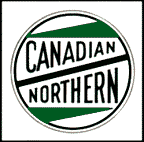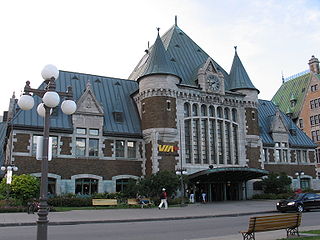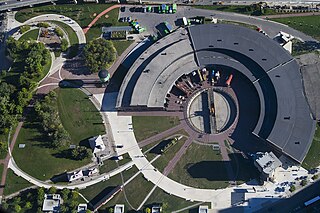
The Canadian Pacific Railway, also known simply as CPR or Canadian Pacific and formerly as CP Rail (1968–1996), is a Canadian Class I railway incorporated in 1881. The railway is owned by Canadian Pacific Railway Limited, which began operations as legal owner in a corporate restructuring in 2001.

Smiths Falls is a town in Eastern Ontario, Canada, 72 kilometres (45 mi) southwest of Ottawa. As of the 2021 census it has a population of 9,254. It is in the Census division for Lanark County, but is separated from the county. The Rideau Canal waterway passes through the town, with four separate locks in three locations and a combined lift of over 15 metres (49.2 ft).

The Grand Trunk Railway was a railway system that operated in the Canadian provinces of Quebec and Ontario and in the United States states of Connecticut, Maine, Michigan, Massachusetts, New Hampshire, and Vermont. The railway was operated from headquarters in Montreal, Quebec, with corporate headquarters in London, United Kingdom. It cost an estimated $160 million to build. The Grand Trunk, its subsidiaries, and the Canadian Government Railways were precursors of today's Canadian National Railway.

The Canadian Northern Railway (CNoR) was a historic Canadian transcontinental railway. At its 1923 merger into the Canadian National Railway, the CNoR owned a main line between Quebec City and Vancouver via Ottawa, Winnipeg, and Edmonton.
The Ontario and Quebec Railway (O&Q) was a historic railway located in southern and eastern Ontario, Canada. It was initially chartered in March 1881 by managers of the Canadian Pacific Railway to run between Toronto and Perth, where it would connect, via a short branch line, to the CPR-controlled Brockville and Ottawa Railway. Construction began in 1882, and the line was completed in August 1884.

The Toronto, Hamilton and Buffalo Railway was a railway based in Hamilton that ran in Southern Ontario from 1892 to 1987. It never reached the other two cities in its name, although it did have branch lines extending to Dunnville and Port Maitland.
The Bytown and Prescott Railway (B&PR) was a railway joining Ottawa with Prescott on the Saint Lawrence River. The company was incorporated in 1850, and the first train ran from Prescott into Bytown on Christmas Day, 1854. The 84 km railway, Ottawa's first to outside markets, was initially used to ship lumber collected on the Ottawa River for further shipping along the St. Lawrence to markets in the United States and Montreal.

Smiths Falls railway station in Smiths Falls, Ontario, Canada is served by Via Rail Corridor trains running between Toronto and Ottawa. It is unstaffed, with outdoor parking, telephones and washrooms. Accessible parking, automatic doors and wheelchair access is available to the platform. However, as of June 2020 no wheelchair lift is available for boarding or disembarking trains at the station.
The South Simcoe Railway is a steam heritage railway in Tottenham, Ontario, north of Toronto. Operating excursions since 1992, it is the oldest operating steam heritage railway in Ontario and features the second oldest operating steam locomotive in Canada.

Gare du Palais is a train and bus station in Quebec City, Quebec, Canada. Its name comes from its proximity to the Palace of the Intendant of New France. It is served by Via Rail, Canada's national passenger railway, and by the private coach company Orléans Express.

The Huron Central Railway is a railway operating in northern Ontario, Canada. It is operated by Genesee & Wyoming Canada, the Canadian subsidiary of Genesee & Wyoming.

Essex Terminal Railway is a Canadian shortline terminal railroad, running from the City of Windsor, Ontario through LaSalle, to Amherstburg, Ontario, for a distance of approximately 21 miles (34 km). ETR has direct connections to Canadian Pacific Railway, Canadian National Railway and CSX. ETR is owned by Morterm Holdings. Founded in 1902, it is one of the oldest existing railways in Canada.
The Ottawa, Arnprior and Parry Sound Railway, or OA&PS, is a historic railway that operated in central and eastern Ontario, Canada from 1897 until 1959. It was, for a time, the busiest railway route in Canada, carrying both timber and wood products from today's Algonquin Provincial Park areas, as well as up to 40% of the grain traffic from the Canadian west from Depot Harbour at Parry Sound through to the St. Lawrence River valley.
The Victoria Railway is a historic 55.52-mile (89.35 km) long Canadian railway that operated in Central Ontario. Construction under Chief Engineer James Ross began in 1874 from Lindsay, Ontario, with authority to build through Victoria County to Haliburton, Ontario, to which it opened on November 24, 1878. The line is best known as having been built by a large group of Icelandic immigrants, who found the Kinmount winters too rough, and so they all moved to Gimli, Manitoba. The line became part of the Midland Railway of Canada and then later part of the Canadian National Railways. The line was abandoned completely by the early 1990s.

Roundhouse Park is a 17 acre park in the downtown core of Toronto, Ontario, Canada. It is in the former Railway Lands. It features the John Street Roundhouse, a preserved locomotive roundhouse which is home to the Toronto Railway Museum, Steam Whistle Brewing, and the restaurant and entertainment complex The Rec Room. The park is also home to a collection of trains, the former Canadian Pacific Railway Don Station, and the Roundhouse Park Miniature Railway. The park is bounded by Bremner Boulevard, Lower Simcoe Street, Lake Shore Boulevard West/Gardiner Expressway and Rees Street.

Ottawa Valley Railway is a Canadian railway that operates 150 miles (240 km) of track in the provinces of Ontario and Quebec, and is owned by Genesee & Wyoming Canada Inc., the Canadian subsidiary of Genesee & Wyoming Inc.

The Brockville and Ottawa Railway (B&O) was an early railway in Upper Canada, today's Ontario. It ran north from the town of Brockville on the Saint Lawrence River to Sand Point on the Ottawa River. It was built primarily to serve the timber trade on the Ottawa Valley, shortcutting routes that led into the city of Ottawa, further downstream. The first railway tunnel in Canada, the Brockville Tunnel, was dug in order to allow the B&O to reach the port lands on the south side of the city, which sits on a bluff.
The Georgian Bay and Seaboard Railway (GB&S) was a former short-line railway in Ontario, Canada, owned and operated by Canadian Pacific Railway (CPR). The first sections opened in 1908, and the entire 140 kilometres (87 mi) route was fully completed in 1912.

The Railway Museum of Eastern Ontario, a rail museum in a former CNoR station, stands on the abandoned right-of-way of a Canadian Northern Railway line which once led southwest toward Napanee. Established 1985 as the Smiths Falls Railway Museum, the RMEO works to preserve the 1913 Canadian Northern (CNoR) station and a collection of historic rolling stock, equipment and railway memorabilia.
The Glengarry and Stormont Railway (G&SR) was a short line railway running from the town of Cornwall in eastern Ontario to connect to the Canadian Pacific Railway's (CP) Ontario and Quebec Railway (O&Q) mainline just inside the Quebec border, a total distance of about 45 kilometres (28 mi). The name refers to the counties it passed through, today amalgamated as Stormont, Dundas and Glengarry.

















